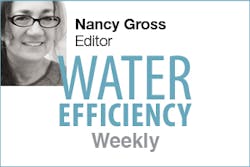The question “What is the origin of the phrase ‘it’s raining cats and dogs?’” is given a full page entry on the website Every Day Mysteries – Fun science facts from the Library of Congress. I share their answers below, but if playing with language evolution isn’t to your fancy, please go ahead and pounce upon the second half of this blog post (begin at the asterisk) to learn about StormCon, the premier stormwater conference and exposition put on by Forester Media and happening again this summer.
The first recorded use of a phrase similar to “raining cats and dogs” was in the 1651 collection of poems Olor Iscanus. British poet Henry Vaughan referred to a roof that was secure against “dogs and cats rained in shower.” One year later, Richard Brome, an English playwright, wrote in his comedy City Witt, “It shall rain dogs and polecats.” (Polecats are related to the weasel and were common in Great Britain through the end of the nineteenth century.)
In 1738, Jonathan Swift published his “Complete Collection of Genteel and Ingenious Conversation,” a satire on the conversations of the upper classes. One of his characters fears that it will “rain cats and dogs.” Whether Swift coined the phrase or was using a cliché, his satire was likely the beginning of the phrase’s popularity. Other British writers have employed less popular phrases, such as “it’s raining pitchforks” or “it’s raining stair-rods,” to describe the shaft-like appearance of heavy rains. But Swift’s phrase may have been memorable enough to stick in the mind of the public.
Swift also wrote a poem, “City Shower” (1710), that described floods that occurred after heavy rains. The floods left dead animals in the streets, and may have led locals to describe the weather as “raining cats and dogs.”
Why “cats and dogs”?
Again, we don’t know for certain. Etymologists—people who study the origins of words—have suggested a variety of mythological and literal explanations for why people say “it’s raining cats and dogs” to describe a heavy downpour. Here are some of the popular theories:
-
Odin, the Norse god of storms, was often pictured with dogs and wolves, which were symbols of wind. Witches, who supposedly rode their brooms during storms, were often pictured with black cats, which became signs of heavy rain for sailors. Therefore, “raining cats and dogs” may refer to a storm with wind (dogs) and heavy rain (cats).
-
“Cats and dogs” may come from the Greek expression cata doxa, which means “contrary to experience or belief.” If it is raining cats and dogs, it is raining unusually or unbelievably hard.
-
“Cats and dogs” may be a perversion of the now obsolete word catadupe. In old English, catadupe meant a cataract or waterfall. A version of catadupe existed in many old languages.In Latin, for example, catadupa. was borrowed from the classical Greek κατάδουποι, which referred to the cataracts of the Nile River. So, to say it’s raining “cats and dogs” might be to say it’s raining waterfalls.
-
A false theory stated that cats and dogs used to cuddle into thatch roofs during storms and then be washed out during heavy rains. However, a properly maintained thatch roof is naturally water resistant and slanted to allow water to run off. In order to slip off the roof, the animals would have to be lying on the outside—an unlikely place for an animal to seek shelter during a storm.
* Are you aware of our sister publication, Stormwater? And the affiliated StormCon, the largest stormwater prevention conference and exposition? StormCon will take place in Austin, TX from Tuesday August 4 through Thursday August 6 and will have seven program tracks: BMP Case Studies, Green Infrastructure, Stormwater Program Management, Water-Quality Monitoring, Industrial Stormwater Management, and Advanced Research Topics. There will also be a special track that is being developed especially for the Austin event by Texas A&M University.
The complete conference program is available here as a pdf.
If you’re looking for detailed information on the individual presentations, brief abstracts are available here.
Details of the five full-day preconference classes, which will take place on August 3, are available here.
The full-conference package runs $565. There are a number of different options, depending whether you choose the full-conference, two-day, or one-day options. You can see all the options here and fill out the online registration form here.
Moderators Needed!
If you will be attending the conference, keep in mind that we are always looking for moderators for the 60- and 90-minute sessions (two or three presentations per session). If you’d like to moderate a session, contact Stormwater’s Editor, Janice Kaspersen, at [email protected]. Let her know the times you’re available or the particular session you’re interested in.
For questions about registration, contact Brigette Burich, 805-679-7631, [email protected].
